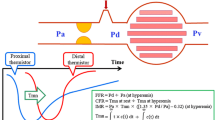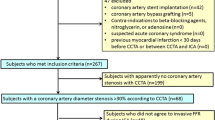Abstract
The fractional flow reserve (FFR) is considered to be a reliable index for the assessment of clinically relevant coronary artery stenosis. However, mismatch in assessing the severity of coronary stenosis between coronary angiography and the FFR has been pointed out. The cardiovascular intervention therapeutics (CVIT)-DEFER registry is a prospective multicenter registry study that has enrolled 3,228 consecutive patients among 3,804 patients with angiographically moderate coronary artery lesions in whom FFR analysis was clinically indicated. The demographic and angiographic parameters associated with an FFR ≤0.8 were analyzed, and the incidence of discrepancy between the angiographic severity of coronary stenosis and the FFR was assessed. Based on the visual assessment, 1,609 (42.9 %) lesions were categorized as showing 50 % stenosis, 1,882 lesions (50.2 %) as 75 % stenosis, and 257 lesions (6.9 %) as 90 % stenosis. Angiographic–FFR “mismatch,” which was defined as visual stenosis ≥75 % with FFR >0.80, was found in 43.4 % of lesions, while reverse angiographic mismatch (visual stenosis <75 % with FFR ≤0.8) was found in 23.2 %. The independent predictors for “angiographic–FFR mismatch” were the presence of percutaneous coronary intervention (PCI) history, one-vessel disease, non-left anterior descending artery (LAD) location, non-diffuse lesion, non-ostial lesion, and non-tandem lesion. Conversely, “reverse angiographic mismatch” was independently associated with the multivessel disease, LAD location, and diffuse lesion. The FFR is not only influenced by luminal stenosis but also by coronary artery morphology and the amount of jeopardized myocardium. Angiographic–FFR mismatch is frequent in patients with moderate coronary stenosis, which suggests the clinical importance of using physiological assessment to guide PCI.



Similar content being viewed by others
References
Pijls NH, van Son JA, Kirkeeide RL, De Bruyne B, Gould KL. Experimental basis of determining maximum coronary, myocardial, and collateral blood flow by pressure measurements for assessing functional stenosis severity before and after percutaneous transluminal coronary angioplasty. Circulation. 1993;87:1354–67.
Pijls NH, Van Gelder B, Van der Voort P, Peels K, Bracke FA, Bonnier HJ, et al. Fractional flow reserve: a useful index to evaluate the influence of an epicardial coronary stenosis on myocardial blood flow. Circulation. 1995;92:3183–93.
De Bruyne B, Bartunek J, Sys SU, Pijls NHJ, Heyndrickx GR, Wijns W. Simultaneous coronary pressure and flow velocity measurements in humans: feasibility, reproducibility, and hemodynamic dependence of coronary flow velocity reserve, hyperemic flow versus pressure slope index, and fractional flow reserve. Circulation. 1996;94:1842–9.
Tonino PAL, De Bruyne B, Pijls NHJ, Siebert U, Ikeno F, van’t Veer M, et al. Fractional flow reserve versus angiography for guiding PCI in patients with multivessel coronary disease (FAME study). N Engl J Med. 2009;360:213–24.
Pijls NH, Fearon WF, Tonino PA, Siebert U, Ikeno F, Bornschein B, et al. Fractional flow reserve versus angiography for guiding percutaneous coronary intervention in patients with multivessel coronary artery disease: 2-year follow-up of the FAME (fractional flow reserve versus angiography for multivessel evaluation) study. J Am Coll Cardiol. 2010;56:177–84.
De Bruyne B, Pijls NHJ, Kalson B, Barbato E, Tonino PAL, Pireth Z, et al. Fractional flow reserve-guided PCI versus medical therapy in stable coronary disease. N Engl J Med. 2012;367:991–1001.
Pijls NHJ, van Schaardenburgh P, Manoharan G, Boersma E, Bech JW, van’t Veer M, et al. Percutaneous coronary intervention of functionally non-significant stenosis: 5-year follow-up of the DEFER study. J Am Coll Cardiol. 2007;49:2105–11.
Park SJ, Kang SJ, Ahn JM, Shim EB, Kim YT, Yun SC, et al. Visual–functional mismatch between coronary angiography and fractional flow reserve. J Am Coll Cardiol Interv. 2012;5:1029–36.
Seo MK, Koo BK, Kim JH, Shin DH, Yang HM, Park KW, et al. Comparison of hyperemic efficacy between central and peripheral venous adenosine infusion for fractional flow reserve measurement. Circ Cardiovasc Interv. 2012;5:401–5.
De Bruyne B, Pijls NH, Barbato E, Bartunek J, Bech JW, Wijns W, Heyndrickx GR. Intracoronary and intravenous adenosine 5′-triphosphate, adenosine, papaverine, and contrast medium to assess fractional flow reserve in humans. Circulation. 2003;107:1877–83.
Yong AS, Ng AC, Brieger D, Lowe HC, Ng MK, Kritharides L. Three-dimensional and two-dimensional quantitative coronary angiography, and their prediction of reduced fractional flow reserve. Eur Heart J. 2011;32:345–53.
Zir LM, Miller SW, Dinsmore RE, Gilbert JP, Harthorne JW. Interobserver variability in coronary angiography. Circulation. 1976;53:627–32.
Boden WE, O’Rourke RA, Teo KK, et al. Optimal medical therapy with or without PCI for stable coronary disease. N Engl J Med. 2007;356:1503–16.
Serruys PW, Morice MC, Kappetein AP, Colombo A, Holmes DR, Mack MJ, et al. Percutaneous coronary intervention versus coronary-artery bypass grafting for severe coronary artery disease. N Engl J Med. 2009;360:961–72.
Leone AM, De Caterina AR, Basile E, Gardi A, Laezza D, Mazzari MA, et al. Influence of the amount of myocardium subtended by a stenosis on fractional flow. Circ Cardiovasc Interv. 2013;6:29–36.
Tonino PAL, Fearon WF, De Bruyne B, Oldroyd KG, Leesar MA, Ver Lee PN, et al. Angiographic versus functional severity of coronary artery stenoses in the FAME study. Fractional flow reserve versus angiography in multivessel evaluation. J Am Coll Cardiol. 2010;55:2816–21.
Brosh D, Higano ST, Lennon RJ, Holmes DR, Lerman A. Effect of lesion length on fractional flow reserve in intermediate coronary lesions. Am Heart J. 2005;150:338–43.
Author information
Authors and Affiliations
Corresponding author
Additional information
For the CVIT-DEFER registry.
Appendix: Associate institutions
Appendix: Associate institutions
(in alphabetical order)
-
1.
Aichi Medical University Hospital
-
2.
Akashi City Hospital
-
3.
Akita Medical Center
-
4.
Cardiovascular Center Hokkaido Ohno Hospital
-
5.
Caress Sapporo Hokko Memorial Hospital
-
6.
Caress Sapporo Tokeidai Memorial Hospital
-
7.
Chiba Tokushukai Hospital of Interventional Cardiology
-
8.
Chigasaki Municipal Hospital
-
9.
Chikamori Hospital
-
10.
Chubu Rosai Hospital
-
11.
Dokkyo Medical University
-
12.
Ebina General Hospital
-
13.
Edogawa Hospital
-
14.
Fujita Health University Hospital
-
15.
Fukui Prefectural Hospital
-
16.
Fukuoka City Medical Association Hospital
-
17.
Fukuoka Tokushukai Medical Center
-
18.
Fukuyama City Hospital
-
19.
Gifu Heart Center
-
20.
Hakodate City Hospital
-
21.
Hakujikai Memorial Hospital
-
22.
Handa City Hospital
-
23.
Higashi Takarazuka Satoh Hospital
-
24.
Hiratsuka Kyosai Hospital
-
25.
Hirosaki University School of Medicine & Hospital
-
26.
Hiroshima City Asa Hospital
-
27.
Hiroshima City Hospital
-
28.
Hiroshima General Hospital of West Japan Railway Company
-
29.
Hokkaido Social Insurance Hospital
-
30.
Hokkaidoh Chuo Rosai Hospital
-
31.
Hyogo College of Medicine
-
32.
Ibaraki Prefectural Central Hospital
-
33.
Ibaraki Seinan Medical Center Hospital
-
34.
International Goodwill Hospital
-
35.
Ishikawa Prefectural Central Hospital
-
36.
IUHW Atami Hospital
-
37.
Iwaki Kyouritsu Hospital
-
38.
Iwate Medical University Hospital
-
39.
Iwate Prefectural Central Hospital
-
40.
Japan Red Cross Hadano Hospital
-
41.
Japan Red Cross Kyoto Daini Hospital
-
42.
Japan Red Cross Matsue Hospital
-
43.
Japan Red Cross Osaka Hospital
-
44.
Japan Red Cross Otsu Hospital
-
45.
Japan Red Cross Shobara Hospital
-
46.
Japanese Red Cross Karatsu Hospital
-
47.
Japanese Red Cross Musashino Hospital
-
48.
Japanese Red Cross Okayama Hospital
-
49.
Japanese Red Cross Wakayama Medical Center
-
50.
Juntendo University Shizuoka Hospital
-
51.
Kagawa Prefectural Central Hospital
-
52.
Kainan Hospital
-
53.
Kameda Medical Center
-
54.
Kanagawa Cardiovascular and Respiratory Center
-
55.
Kanoya Heart Center
-
56.
Kansai Medical University Takii Hospital
-
57.
Kasugai Municipal Hospital
-
58.
Kawasaki Medical School Hospital
-
59.
Kinki University Hospital, Faculty of Medicine
-
60.
Kitaibaraki City Hospital
-
61.
Kitasato University Medical Center
-
62.
Kizawa Memorial Hospital
-
63.
KKR Sapporo Medical Center
-
64.
Kobe Rousai Hospital
-
65.
Kobe University Hospital
-
66.
Kokura Memorial Hospital
-
67.
Komaki City Hospital
-
68.
Kouseiren Takaoka Hospital
-
69.
Kuki General Hospital
-
70.
Kurashiki Central Hospital
-
71.
Kurume University Hospital
-
72.
Kyoto University Hospital
-
73.
Kyushu Kousei Nenkin Hospital
-
74.
Matsue City Hospital
-
75.
Matsue Seikyo General Hospital
-
76.
Mie Heart Center
-
77.
Mie University Hospital
-
78.
Miki City Hospital
-
79.
Misato Central General Hospital
-
80.
Misyuku Hospital
-
81.
Mito Saiseikai General Hospital
-
82.
Mitsubishi Kyoto Hospital
-
83.
Mitsui Memorial Hospital
-
84.
Miyagi Cardiovascular and Respiratory Center
-
85.
Miyagi East Department of Cardiology
-
86.
National Hospital Organization Hakodate National Hospital
-
87.
National Hospital Organization Kyushu Medical Center
-
88.
National Hospital Organization Takasaki General Medical Center
-
89.
Nihon University School of Medicine, Itabashi Hospital
-
90.
Nihonkai General Hospital
-
91.
Niigata City General Hospital
-
92.
Nippon Medical School Chiba Hokusoh Hospital
-
93.
Nishiarai Heart Center Hospital
-
94.
Nishinomiya Watanabe Cardiovascular Center
-
95.
Obihiro Hospital
-
96.
Oe Kyodou Hospital
-
97.
Ogikubo Hospital
-
98.
Oita Oka Hospital
-
99.
Oita University Hospital
-
100.
Oitaken Kouseiren Tsurumi Hospital
-
101.
Okamura Memorial Hospital
-
102.
Okinawa Prefectural Chubu Hospital
-
103.
Osaka City General Hospital
-
104.
Osaka Saiseikai Nakatsu Hospital
-
105.
Osaka University Hospital
-
106.
Osaki Citizen Hospital
-
107.
Rakuwakai Marutamachi Hospital
-
108.
Rakuwakai Otowa Hospital
-
109.
Saga Prefectural Medical Center Koseikan
-
110.
Saiseikai Kumamoto Hospital
-
111.
Saitama Cardiovascular and Respiratory Center
-
112.
Saitama Eastern Cardiovascular Hospital
-
113.
Sakakibara Memorial Hospital
-
114.
Sakurabashi Watanabe Hospital
-
115.
Sapporo Cardiovascular Clinic
-
116.
Sassa General Hospital
-
117.
Seirei Hamamatsu General Hospital
-
118.
Seirei Mikatahara General Hospital
-
119.
Sendai City Hospital
-
120.
Sendai Open Hospital
-
121.
Shimada Municipal Hospital
-
122.
Shimane Prefectural Central Hospital
-
123.
Shimane University Hospital
-
124.
Shinbeppu Hospital
-
125.
Shinkawabashi Hospital
-
126.
Shinshu University Hospital
-
127.
Shirane Tokushukai Hospital
-
128.
Shiroyama Hospital
-
129.
Shonai Amarume Hospital
-
130.
Social Insurance Chukyo Hospital
-
131.
St. Marianna University School of Medicine Hospital
-
132.
Steel Memorial Muroran Hospital
-
133.
Surugadai Nihon University Hospital
-
134.
Suzuka Central General Hospital
-
135.
TACHIKAWA Medical Center
-
136.
Tachikawa Sougo Hospital
-
137.
Teikyo University Hospital
-
138.
Teniwa Keijinkai Hospital
-
139.
Tenyokai Chuo Hospital
-
140.
The Cardiovascular Institute
-
141.
The University of Tokyo Hospital
-
142.
Toho University Ohashi Medecal Center
-
143.
Tokushima Prefectural Central Hospital
-
144.
Tokushima University Hospital
-
145.
Tokyo Dental College Ichikawa General Hospital
-
146.
Tokyo Medical University Hachioji Medical Center
-
147.
Tokyo Medical University Hospital
-
148.
Tokyo Metropolitan Bokutoh Hospital
-
149.
Tokyo Metropolitan Hiroo General Hospital
-
150.
Tokyo Metropolitan Tama Medical Center
-
151.
Toshima Hospital
-
152.
Tottori Prefectural Central Hospital
-
153.
Tottori University Hospital
-
154.
Toyohashi Municipal Hospital
-
155.
Tsuchiura Kyodo General Hospital
-
156.
University of Tsukuba Hospital
-
157.
Uwajima City Hospital
-
158.
Wakayama Medical University Hospital
-
159.
Yamaguchi Rousai Hospital
-
160.
Yamato Seiwa Hospital
-
161.
Yokohama Asahi Chuo General Hospital
-
162.
Yokohama Central Hospital
-
163.
Yokohama City University Hospital
-
164.
Yokohama City University Medical Hospital
-
165.
Yokohama Sakae Kyosai Hospital
-
166.
Yokohamashintoshi Neurosurgical Hospital
-
167.
Yokosuka Kyosai Hospital
-
168.
Yotsuba Circulation Clinic
Rights and permissions
About this article
Cite this article
Nakamura, M., Yamagishi, M., Ueno, T. et al. Prevalence of visual–functional mismatch regarding coronary artery stenosis in the CVIT-DEFER registry. Cardiovasc Interv and Ther 29, 300–308 (2014). https://doi.org/10.1007/s12928-014-0259-3
Received:
Accepted:
Published:
Issue Date:
DOI: https://doi.org/10.1007/s12928-014-0259-3




